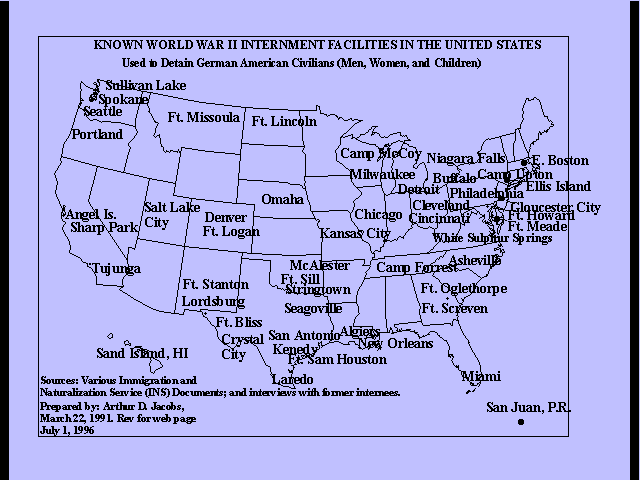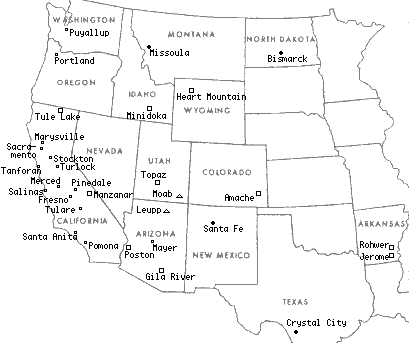 1
1...Victims of war time hysteria, these people, two-thirds of whom were United States citizens, lived a bleak humiliating life in tar paper barracks behind barbed wire and under armed guard...
- Sign at the Minidoka Relocation Center2[The construction] is so very cheap that, frankly, if it stands up for the duration we are going to be lucky.
- Milton Eisenhower, before Senate appropirations committee9
 1
1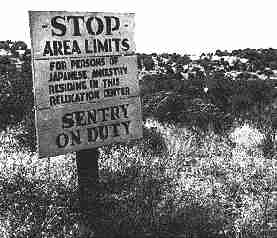 10
10"Relocation
Centers"
Permanent detention camps that held internees from March,
1942 until their closing in 1945 and 1946.2
Amache (Granada), CO
Opened August 24, 1942. Closed October 15, 1945. Peak population 7318. Origin of prisoners: Nothern California coast, West Sacramento Valley, Northern San Joaquin Valley, Los Angeles. 31 Japanese Americans from Amache volunteered and lost their lives in World War II. 120 died here between August 27, 1942 and October 14, 1945. In April, 1944, 36 draft resisters were sent to Tucson, AZ Federal Prison Camp.2Opened July 20, 1942. Closed November 10, 1945. Peak Population 13,348. Origin of prisoners: Sacramento Delta, Fresno County, Los Angeles area. Divided into Canal Camp and Butte Camp. Over 1100 citizens from both camps served in the U.S. Armed Services. The names of 23 war dead are engraved on a plaque here. The State of Arizona accredited the schools in both camps. 97 students graduated from Canal High School in 1944. Nearly 1000 prisoners worked in the 8000 acres of farmland around Canal Camp, growing vegetables and raising livestock.2 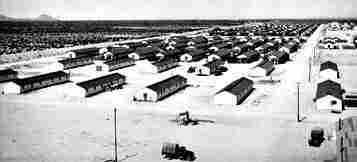
Canal Camp.3Opened August 12, 1942. Closed November 10, 1945. Peak population 10,767. Origin of prisoners: Santa Clara County, Los Angeles, Central Washington. In November, 1942, Japanese American hospital workers walked out because of pay discrimination between Japanese American and Caucasian American workers. In July, 1944, 63 prisoners who had resisted the draft were convicted and sentenced to 3 years in prison. The camp was made up of 468 buildings, divided into 20 blocks. Each block had 2 laundry-toilet buildings. Each building had 6 rooms each. Rooms ranged in size from 16' x 20' to 20' x 24'. There were 200 administrative employees, 124 soldiers, and 3 officers. Military police were stationed in 9 guard towers, equipped with high beam search lights, and surrounded by barbed wire fencing around the camp.2
Heart Mountain. From Tom Parker, August 28, 1942, National Archives.7Jerome, AR
Opened October 6, 1942. Closed June 30, 1944. Peak population 8497. Origin of prisoners: Central San Joaquin Valley, San Pedro Bay area. After the Japanese Americans in Jerome were moved to Rohwer and other camps or relocated to the east in June, 1944, Jerome was used to hold German POWs.2Opened March 21, 1942. Closed November 21, 1945. Peak population 10,046. Origin of prisoners: Los Angeles, San Fernando Valley, San Joaquin County, Bainbridge Island, Washington.2 The first of the ten camps to open -- first as a processing center.5
Manzanar dust storm. Dorothea Lange, July 3, 1942.4Opened August 10, 1942. Closed October 28, 1945. Peak population 9397. Origin of prisoners: Seattle and Pierce County, Washington, Portland and Northwestern Oregon. 73 Minidoka prisoners died in military service.2
The sky reflecting in the mud at Minidoka.
Francis Stewart, December 10, 1942. From National Archives.7Poston (aka Colorado River)5, AZ
Opened May 8, 1942. Closed November 28, 1945. Peak population 17,814. Origin of prisoners: Southern California, Kern County, Fresno, Monterey Bay Area, Sacramento County, Southern Arizona. 24 Japanese Americans held at Poston later lost their lives in World War II.2 Poston was divided into three separate camps -- I, II, and III.5
Poston was constructed on the Colorado River Indian Reservation.
Clem Albers, April 10, 1942. From National Archives.8Rohwer, AR
Opened September 18, 1942. Closed November 30, 1945. Peak population 8475. Origin of prisoners: Los Angeles and Stockton.2Topaz (aka Central Utah)5, UT
Opened September 11, 1942. Closed October 31, 1945. Peak population 8130. Origin of prisoners: San Francisco Bay Area.2Tule Lake, CA
Opened May 27, 1942. Closed March 20, 1946. Peak population 18,789. Origin of prisoners: Sacramento area, Southwestern Oregon, and Western Washington; later, segregated internees were brought in from all West Coast states and Hawaii. One of the most turbulent camps -- prisoners held frequent protest demonstrations and strikes. Tule Lake had the most "No-No" answers to the 2-part loyalty oath question. As a result, it was made a "segregation camp" and was used to hold prisoners from other camps who had also refused to take the loyalty oath. Many, such as Kibei and those who renounced their U.S. citizenship, later went to Japan.2
In all, 120,313 people were under WRA control. 90,491 were transfered from assembly centers; 17,491 were taken directly from their homes; 5918 were born to imprisoned parents; 1735 were transferred from INS internment camps; 1579 were moved here after being sent from assembly centers to work crops; 1275 were transfered from penal and medial institutions; 1118 were taken from Hawaii; and 219, mostly non-Japanese spouses, entered voluntarily.7
Of these 120,313: 54,127 returned to the West Coast after their incarceration; 52,798 relocated to the interior; 4724 moved (or were moved) to Japan; 3121 were sent to INS internment camps; 2355 joined the armed forces; 1862 died during imprisonment; 1322 were sent to institutions; and 4 were classified as "unauthorized departures."7
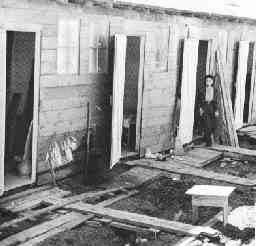
Fresno, CA
First inmate arrival May 6, 1942. Last inmate departure October 30, 1942. Peak population 5120.5Manzanar, CA
First inmate arrival March 21, 1942. Peak population (before June 1, 1942) 9666. Before it was leased from the City of Los Angeles, Manzanar used to be ranch and farm land until it reverted to desert conditions. Manzanar was transfered from the WCCA to WRA on June 1, 1942, and converted into a "relocation camp."5Marysville, CA
First inmate arrival May 8, 1942. Last inmate departure June 29, 1942. Peak population 2451.5Mayer, AZ
First inmate arrival May 7, 1942. Last inmate departure June 2, 1942. Peak population 245. Mayer was a camp abaondoned by the Civilian Conservation Corp.5Merced, CA
First inmate arrival May 6, 1942. Last inmate departure September 15, 1942. Peak population 4508.5Pinedale, CA
First inmate arrival May 7, 1942. Last inmate departure July 23, 1942. Peak population 4792. Pinedale was the previous site of a mill.5Pomona, CA
First inmate arrival May 7, 1942. Last inmate departure August 24, 1942. Peak population 5434.5Portland, OR
First inmate arrival May 2, 1942. Last inmate departure September 10, 1942. Peak population 3676. Portland used the Pacific International Live Stock Exposition Facilities to hold detainees.5Puyallup, WA
First inmate arrival April 28, 1942. Last inmate departure September 12, 1942. Peak population 7390.5Sacramento, CA
First inmate arrival May 6, 1942. Last inmate departure June 26, 1942. Peak population 4739. Sacramento used a former migrant camp.5Salinas, CA
First inmate arrival April 27, 1942. Last inmate departure July 4, 1942. Peak population 3594.5Santa Anita, CA
First inmate arrival March 27, 1942. Last inmate departure October 27, 1942. Peak population 18,719.5Stockton, CA
First inmate arrival May 10, 1942. Last inmate departure October 17, 1942. Peak population 4271.5Tanforan, CA
First inmate arrival April 28, 1942. Last inmate departure October 13, 1942. Peak population 7816.5Tulare, CA
First inmate arrival April 20, 1942. Last inmate departure September 4, 1942. Peak population 4978.5Turlock, CA
First inmate arrival April 30, 1942. Last inmate departure August 12, 1942. Peak population 3662.5
